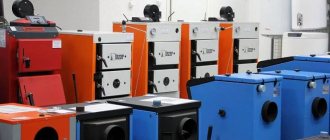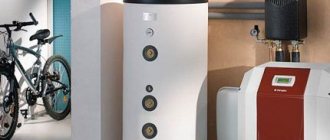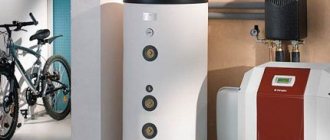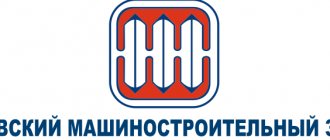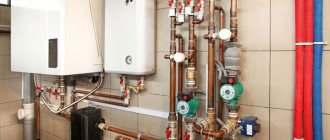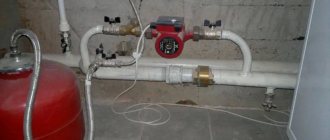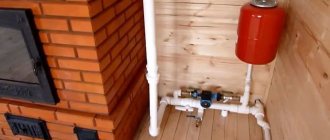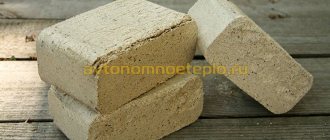If there is no main gas pipeline nearby, then modern pellet heating boilers will be the most effective and economical option for heating residential or non-residential buildings. In addition, such units are characterized by durability, the ability to operate autonomously and safety.
To ensure that the operation of the boiler does not cause trouble, and the purchase does not disappoint, it is necessary to carefully approach the issue of choosing equipment.
We will help you in this matter. The article presents the pros and cons of pellet boilers, indicates the features of their operation and maintenance, and also describes in detail the characteristics and parameters that should be taken into account when purchasing.
Types of pellet boilers
Depending on the fuel options used, we can distinguish:
- Pellet
– for one type of fuel.
Units that use only compressed granules.
- Combined.
Universal models in which firewood, peat briquettes, coal and other types of fuel can be used as additional raw materials. The boilers are equipped with an additional chamber with manual fuel loading. This option is very convenient if you run out of pellets.
Depending on the built-in burner, devices are distinguished:
- With retort burner
– a simple design in which fuel is supplied to the device from bottom to top. Retort models are compact in size and less sensitive to debris inclusions in the granules. Fine coal can be used as fuel. However, this type of device has lower efficiency.
- With torch burner
– more modern and technological devices. They have automatic ignition and a self-cleaning system, are distinguished by smooth flame modulation and the possibility of weekly programming. Only pellet granules are used as raw materials
Depending on the type of bunker, there are:
- Compact
. The pellet box is attached to the heat exchanger body. The volume of the bunker in this case is determined by the manufacturer and cannot be changed. It is worth considering the space in the boiler room to place such a device.
- With free-standing bunker
. The bunker can be placed in any convenient place from the boiler. The distance depends on the length of the burner screw. The volume is selected at the request of the buyer, depending on the need and level of autonomy.
Criterias of choice
When choosing a pellet boiler, you should pay special attention to the type of built-in pellet burner. The burner is the heart of a pellet heating boiler. It depends on it how well the purchased device will work.
Choose a boiler with a flare burner. They have automatic ignition and self-cleaning functions. It is worth keeping in mind that retort burners are cheaper, but the automatic functions of the torch analogue will not be available. You, as with the option of a solid fuel boiler with manual loading of fuel, will have to light the fire manually and approach the boiler at frequent intervals to clean it.
In the characteristics of a torch burner, it is also worth paying attention to the quality of the pellets used. Most burners require the use of only clean light pellets, which are more difficult to find in Belarus (mainly manufactured for export to Europe). The cost of such granules is also significantly higher than agropellets (dark, with bark impurities, etc.).
In order not to make a mistake with your choice, we recommend considering heating units with PellasX pellet burners (Poland). These burners are famous for their innovative technologies and, in addition to white pellets, they can also use dirty granules, which reduces the cost of purchasing fuel and simplifies their selection.
Other equally important characteristics that are worth paying attention to:
- The larger the heat exchanger area, the higher the efficiency.
- Heat exchanger wall thickness - special heat-resistant steel with a thickness of at least 4 mm must be used. Affects the service life of the unit.
- The volume of water in the boiler - productivity depends on this.
- Burner automation: control of the burner, indirect heating boiler, ability to connect street and room temperature sensors.
Popular manufacturers
| Manufacturer, model. | Characteristic |
| D'ALESSANDRO Termomeccanika. SCA series model | An Italian brand that is certified in Russia. This is a pellet double-circuit boiler with a three-pass heat exchanger and a cast iron burner. Cylinder-shaped bunker with automatic inverter and fire extinguishing function for 480 l. Air is blown into the combustion chamber by an electric fan. Standard control panel. Electronic control system with GSM module. Automatic electric ignition and support for stable combustion. Setting the flame intensity with a lambda probe. The heat transmitter in the combustion chamber is ceramic. Automatic ash removal function. Bunker filling indicators. Pneumatic slag cleaning function. Additional heater for the hot water circuit. Allows work on pellets, shavings, sawdust, small chips. Feeding of raw materials is twin-screw and with an intermediate hopper. |
| Kostrzewa. range of Pellets Fuzzy Logic II P | Polish brand. The boiler operates in automatic mode on industrial, grain, household wood pellets, small coal, and in manual mode on fuel briquettes, firewood, and coarse coal. The efficiency reaches 90%. There is automatic ignition. Several saving modes (summer, hot water supply, autonomous, weather). Built-in multilingual control system menu. Exhaust gas tabulator and lambda sensor. Three additional retort plates for different types of raw materials. Four-way mixing valve for controlling and branching the flows of two circuits. Three-pass heat exchanger made of steel. Enlarged ash bin. Cleaning is carried out once every five months. Feeding screw made of steel. Economical motor with gearbox. Individual pumps for heating and hot water supply. Many sensors and control circuits. |
| Kiturami. KRP model range | Manufacturer – South Korea. These are double-circuit pellet boilers. Efficiency - 92%. Pellets of the first and second categories are used. There is a built-in circulation pump and a membrane-type expansion tank. Large volume ash receptacle, easy access. Efficient automatic electric igniter with a large area. The design has no reverse draft. There is an overheat protection function and an anti-freeze system. Liquid level indicator sensor in the heating system. A programmer with a wide selection of functions and ready-made economical modes (season setting, switching to hot water supply and autonomous operation). Remote control with program selection. Remote air temperature readings as standard. Increased pellet hopper capacity. The short auger path in the combustion chamber does not damage the wood pellets. |
As you can see, pellet boilers are gradually becoming more and more popular due to their undoubted advantages.
Features of heating with a pellet boiler
The main feature of these units is the use of pellets as the main raw material. This type of fuel is the most environmentally friendly and safe. The fuel contains only compressed wood waste, so during its combustion there is no emission of harmful substances.
From a design point of view, this type of solid fuel boiler also has a number of distinctive properties:
- Fuel bunker. As a rule, a hot water heating unit is supplied together with a pellet bunker where the raw materials are stored. They can be built-in (part of the boiler) or external type.
- Screw. A special mechanism for supplying fuel to the firebox, which is equipped with an electric motor. Using this device, pellets are discharged through a flexible hose into the dispenser.
- Burner. A special burner with flame modulation ensures high efficiency of heating equipment, and its operating efficiency is comparable to gas heat generators.
The multi-pass design of the boiler also increases the heat transfer of the heat exchanger and heating efficiency in general, while the temperature of the combustion products is in the range of 100-200 degrees.
When is pellet boilers most often chosen?
Most often this happens in the absence of a gas main, or when it is impossible to install a gas boiler. Undoubtedly, the gas unit is the most economical and easiest to operate. However, in the absence of the possibility of installing it, almost the only alternative is to purchase a solid fuel boiler. A pellet boiler, as a type of solid fuel device, makes life easier for the owners of a country house. With optimal settings, you can approach the heat generator once a week, and not once every few hours, as is the case with a classic TT unit with manual fuel loading.
Many owners of private houses are also thinking about installing an electric boiler. However, as practice shows, this is a much more expensive device in terms of paying electricity bills. Even taking into account preferential heating tariffs, etc.
Preparing the premises
When installing a pellet boiler, first of all, you need to properly prepare the room where the heating generator will be located. It is better to use an area remote from housing (basements, outbuildings, garages are good options, sometimes boilers are placed in attics).
If the room with the boiler is located close to the living rooms, then it is better to take care of a tight sealed door and covering the floors and doors with washable materials (wood dust and ash will constantly settle on them). The best option for cladding is standard tiles.
The area of the room for a boiler with a power of 15-18 kW should not be less than 2.5-3 square meters. m., otherwise it violates fire safety rules. The temperature in the room was not below +10 degrees; to achieve this, the walls and ceiling can be insulated with polystyrene foam (a layer of 10 centimeters is enough). There is no need for radiators.
Humidity above 40% is not welcome, as it will reduce the service life of the system - if water gets into the room from the roof or through the walls, you will have to line the perimeter with a waterproofing membrane material.
A few more important conditions when preparing the premises:
- Availability of fresh ventilation. A hole with a diameter of 12-15 centimeters is sufficient. No particularly complex air conditioning systems are required. You can make a hood to make the room comfortable to be in.
- Having access to a chimney or organizing a new one. For pellet boilers, only a sandwich type chimney (with a layer of insulation) is suitable. The height of the pipe must be at least 5 meters. It is recommended to install a condensate collector so that moisture accumulation does not interfere with the operation of the furnace.
- Availability of power supply in the room. Pellet boilers require electricity to automate their operation. It is also recommended to install light into the room, which will greatly facilitate the work on servicing the stove.
General diagram, but read more below
Advantages and disadvantages
In addition to the environmental friendliness of the fuel, pellet boilers have significant advantages:
- Simplicity and ease of use.
- Full autonomy. With a sufficient volume of the pellet bunker, heating units can operate without maintenance for up to 1 week.
- High efficiency (up to 92-95% for some models).
- Fire safety. If the necessary requirements for installing a granular unit are met, the risk of fires will be reduced.
- Economical fuel consumption. The automation uses fuel efficiently, while the pellets themselves generate 1.5 times more thermal energy compared to firewood.
- Full automation. Most heat generators are equipped with weather-dependent automation and the ability to remotely control the boiler, which allows for comfortable home heating.
- Long service life. With proper operation and periodic maintenance, the heat generator will last up to 25 years or more.
The main disadvantage of this type of heat generator is its high cost. However, economical fuel consumption and high heating efficiency make it possible to guarantee a quick payback for the purchase of a pellet boiler.
Impressive dimensions are also considered one of the disadvantages of the heating device. It will require quite a lot of space to place and install it.
View from the outside
Pellets need to be loaded into the receiver and this also requires time and effort. This is why many owners create their own storage bin and feeding conveyor. You can order a feed hopper yourself, which will minimize labor costs. In addition, every 2 weeks it is necessary to remove ash from pellets , and if you burned with coal, then it accumulates every day. This is also a significant disadvantage. The high cost of the boiler is relative. In any case, it is cheaper than a gas boiler; in addition, such a boiler is safer to operate.
The boiler requires a hole in the wall, but does not require a special chimney. In addition, when the power is turned off, the fan will automatically stop, so some of the smoke may enter the house. This can also be considered a disadvantage.
The consumption of pellets depends on the volume of the boiler, its power and the temperature outside the house.
At -30, the flow rate can reach 60 kg for a 25 kW boiler, at -5 the flow rate will be 30 kg, at 0 degrees – 22 kg.
You also need to remember that the heating season in the country is on average 5 months, from this you can calculate exactly how much fuel is needed for your home. In addition, we take into account the area of construction and the need for water heating if the boiler is double-circuit.
Some owners, having switched from diesel heating to pellet heating, believe that the costs are recouped in a year. However, we must not forget that the pellets themselves must also be purchased somewhere and delivered to your home, so purchase and transportation costs must also be taken into account. You also need to create a warehouse for storing pellets, which have special requirements for humidity, so you will have to allocate a special room for them.
Whether it makes sense to install this equipment or not, the buyers themselves decide, but many reviews are positive, which means that pellet boilers are quite satisfactory for the owners. Sometimes it’s easier to find firewood than to bring gas cylinders to a village where there is no main gas pipeline, so if you buy a universal boiler, you don’t have to worry about being left without heat for the winter. In addition, a distinctive feature of pellet boilers is complete fire safety , which is why they are in great demand among buyers. Moreover, this design does not depend on electricity or consumes it in a minimal amount, which can be solved with the help of a generator.
Such a pellet boiler can be installed in a house in the middle of nowhere and without having to worry about having to go for gas in winter.
Storing wood pellets
Purchasing a pellet boiler requires additional space or storage for storing compressed wood pellets. They need to be stored in a dry place.
Models with a built-in hopper are characterized by a small volume of the pellet tank, which leads to its constant and frequent replenishment.
External bins may vary in size and volume. The use of such devices allows you to store a significant supply of granules, while maintaining low humidity in the storage.
Which brands of pellet boilers are the best in quality and reliability?
- Lighthouse.
Long-burning pellet units are characterized by high productivity and heat transfer. The heat exchangers are made of high-quality boiler steel with a thickness of 6 mm. The devices are equipped with a highly efficient Polish-made Pellas-X burner and a hopper for storing wood pellets.
- Drew-Met.
The Polish-made automated heating system is characterized by its versatility (in addition to wood pellets, it is possible to use an alternative type of fuel (firewood, wood chips, peat briquettes, etc.)). The heat generators are made of high-strength boiler steel 6 mm thick and equipped with a PellasX pellet burner and LCD Pellas-X S automatic control.
- Tis.
Domestic manufacturer of reliable heating equipment, the efficiency of which reaches 92%. Ideal for use in cold climates. Some models (for example, EKO DUO) allow the use of other types of raw materials, such as firewood, coal or peat.
- Kronas.
The Ukrainian brand of world-class heating equipment is distinguished by economical fuel consumption and high performance due to built-in automation and a torch burner.
- Sas.
Polish manufacturer of solid fuel equipment, which is characterized by automatic control and loading of granular raw materials. All models are made of high-quality heat-resistant steel P265GH. The built-in flare burner ensures stable fuel combustion.
Practical recommendations
Before you start assembling a pellet fireplace stove, you should decide what parts you need to purchase - we are talking about the burner and industrial automation. You should not experiment and assemble the burner yourself. Even if a lot of effort is put into it, its functionality may be very questionable.
It is best to purchase ready-made elements and use them later when assembling a pellet stove. If you make the boiler multifunctional, that is, provide it with a water circuit and the ability to work both on pellets for the fireplace, and on wood and coal, then in the future it can be modernized.
The advantages of a universal boiler will be:
- If there are interruptions in the supply of pellets for the boiler, the boiler can still be used. To do this, remove one burner and put on another to heat the stove with prepared wood and coal.
- Alternatively, you can install a special burner in the boiler for burning natural gas or liquid fuel.
The combustion chamber is usually made of heat-resistant steel 5 mm thick. It is advisable to use ST20 carbon steel for these purposes, but the casing can be made of ST3 sheet steel with a thickness of 3 mm. The fire tubes and chamber doors are made of 6 mm steel, and the grate should be as much as 10 mm thick. In order not to bother with purchasing and assembling parts, sometimes it is much easier to purchase ready-made equipment.
If you make the boiler yourself, you will need a welding machine. The water grate must have very rigid walls. To do this, metal corners or pieces of reinforcement are sometimes welded onto them. At the end of the work, it is necessary to double-check the reliability of all welds. If flaws are found, they must be eliminated.
Conclusion
Heating with pellets is considered one of the most environmentally friendly, economical and safe ways to heat a home. Installing a granular heat generator will not only provide a comfortable heating temperature with economical fuel consumption, but will also create conditions for autonomous operation of the heating system.
Are you looking for a high-quality and reliable heating unit? Contact us! Many years of experience and positive feedback from our customers allow us to guarantee high quality service and an individual approach in selecting the necessary equipment for each client.
